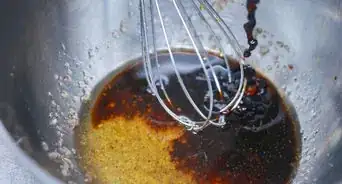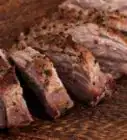This article was co-authored by wikiHow Staff. Our trained team of editors and researchers validate articles for accuracy and comprehensiveness. wikiHow's Content Management Team carefully monitors the work from our editorial staff to ensure that each article is backed by trusted research and meets our high quality standards.
There are 9 references cited in this article, which can be found at the bottom of the page.
The wikiHow Culinary Team also followed the article's instructions and verified that they work.
This article has been viewed 549,442 times.
Learn more...
The king of steaks — filet mignon. It's succulent, tender, and among the rarest cuts on a cow. No wonder it can cost an arm and a leg to get a hold of. But fret not; preparing this pricey cut does not need to be difficult. In fact, once you understand the techniques involved, you'll be able to produce a great-tasting steak no matter what cut you decide to use. Although it may sound funny, the perfect filet mignon requires only salt, pepper, and a bit of oil.
Steps
Preparation
-
1Choose a thick cut of meat. The thicker cut of meat you get, the better. That's because with a thicker cut it's easier to get a nice, crispy crust on the outside without overcooking the inside. The best thickness for filet mignon is anywhere from 2 to 3 inches (5.1 to 7.6 cm) thick.[1] That may seem like a very thick cut, but remember that the steak will shrink a bit as it cooks.
- Go to your local butcher and ask him to cut the filet from the tenderloin. This ensures both a fresher cut and the ability to specify how thick you want your filet to be. Oh, and you get to support your local butcher instead of a supermarket conglomerate.
- What if you have a thin cut of filet mignon? Don't fret, but adjust your cooking accordingly. Instead of slow-cooking your filet, you'll need to sear it over extremely high heat for a short period of time to get a crispy outside and a juicy, medium-rare inside.
-
2Resist the temptation to outfit your filet with additional rubs or smother it in marinades. Beware of recipes that call for rubs or marinades when it comes to filet mignon. All you need is salt and pepper. Using rubs or marinades on filet mignon is likely to make the meat less tasty, not more.Advertisement
-
3Decide whether to salt the filet before or after grilling. Some cooks choose to salt the steak after cooking it, and that's perfectly acceptable. Most cooks, however, salt the filet before grilling, although many of them make the mistake of salting too soon before cooking. Salt at least 40 minutes to an hour before grilling.[2] [3]
- Salt brings moisture out to the surface of the steak. Wouldn't that be bad news for a moist, juicy steak? you ask. It is, if you don't salt far enough in advance.
- For the first 30 minutes of salting, moisture comes out to the surface of the steak, accumulating in small puddles. At this point, cooking the steak would be ill-advised.
- After 30 minutes, some of the moisture drawn out by the salt seeps back into the meat. The process is called osmosis, and it also makes for more tender meat.[4]
- The longer you leave your steaks out after 40 minutes, the more of the salty water travels back into the steak, flavoring and tenderizing it.
- Salt brings moisture out to the surface of the steak. Wouldn't that be bad news for a moist, juicy steak? you ask. It is, if you don't salt far enough in advance.
-
4Wait for the filet to come to room temperature. Most cooks do this while they're waiting for the salt to do its thing. Meat that has come to room temperature before cooking cooks faster and more evenly. Gone are the days of charred outsides and cold insides.
-
5If possible, use lump charcoal over briquettes and try to stay away from gas grills. Gas grills aren't horrible, but they don't burn hot and can impart a gasoline smell to your precious steaks. (Ew.) Stick to charcoal instead. Funny as it might seem, using charcoal instead of gas gives you greater control over the cooking process.[5]
- That's because charcoal is a really solid heat source. It burns hot — much hotter than gas — and burns steadily. If you know how to master charcoal, it gives you a better final product.
- Briquettes are fine, but they're nothing special. Many of them have unwanted additives that give off a faint aroma, so if used, they should be white all over before you start grilling.[6] Lump charcoal burns hotter, is easier to adjust the temperature, and is all-natural.
Cooking
-
1Position your coals to form a hot side and a cool side in your grill. Move all your coals over to one half of the grill; that will be your "hot" half. The half without any coals will be your "cool" side.
-
2Brush your filet with a little bit of oil. Many choose to use a neutral oil, like groundnut oil, because it doesn't have much of a taste. Olive oil is perfectly acceptable for a more distinct taste. Remember that a little oil goes a long way. Use no more than a tablespoon for each filet.
-
3Decide whether to cook your filet primarily over high heat or low heat. There are pretty much two camps when it comes to how to cook meat: the high heat camp and the low heat camp.
- The high heat camp is straightforward: Cook the filet for 2-5 minutes per side over high heat, searing it to seal in the juices. While this method can certainly produce a fine filet mignon, the "searing to seal in the juices" idea has been debunked.[7] In fact, the temperature to which you cook the meat is the most important factor in keeping meat juicy. Placing it over high heat will accelerate the loss of juices.
- The low heat camp uses this fact — the hotter the temperature, the more juices lost — to champion a different approach. Instead of searing first, the meat is cooked over indirect, "cool" heat until it's just below its ideal temperature. It's then seared to develop a crust and depth of flavor.
-
4Cook your filet over indirect, "cool" heat until the filet is about 15° - 20° F from your ideal temperature. Placing over indirect heat will slow the loss of juices, cooking the steak while keeping it moist. Don't be afraid to stick a meat thermometer into your filet. It's a myth and old wives' tale that piercing your filet with a thermometer one time will cause all its juices to run out.[8] (If you don't have a thermometer, you can always use the finger test, although it's less reliable.)
- 120° F (48.8° C) = Rare
- 130° F (54.4° C) = Medium rare
- 140° F (60° C) = Medium
- 150° F (65.5° C) = Medium well
- 160° F (71.1° C) = Well done
-
5For a medium-rare filet, transfer it over to the direct, "hot" side of the grill when its temperature reaches 110° to 115° F. Sear the meat on both sides, using tongs to flip the filet when necessary.
-
6Remove the filet when its internal temperature is 5° F away from its ideal temperature. The steak will continue cooking even after it has been removed from the heat.[9]
-
7Make sure to let the steak rest for 5 to 10 minutes before cutting into it. Cover the steak with aluminum foil and let rest for a while, even if the temptation is killing you. A steak that is cut into immediately after cooking will lose more of its juices than a steak that is allowed to rest for 10 minutes.[10]
- When a steak is cooked, its muscles tighten up on the outside. This pushes all the juices to the inside of the meat, where the muscles aren't as tight because they're not as hot. If you cut into the center of your filet immediately after cooking, the juices accumulated there will simply run out, leaving you with a drier steak.
- If you let your filet rest, however, the muscles begin to relax and the juices move from the center of the steak back out, dispersing more evenly. You'll hold on to 7% more weight in juices by waiting an extra 10 minutes after cooking has finished.[11]
-
8Pepper your steak generously. Many chefs hold off on peppering the steak until after it's been grilled because they don't want the pepper to be burned while grilling. If you're the type of chef who doesn't mind burned pepper mingling with your filet mignon, go ahead and pepper when you salt the filet. If not, pepper now, right before serving.
-
9Serve and enjoy your perfectly cooked king of steaks. Savor each tender, buttery, succulent bite and give thanks to the being that created such a delicious cut of meat.
Community Q&A
-
QuestionFor medium rare, how long do I grill a 2 lb filet?
 Community AnswerIt should be around 3.5 minutes per side. Turn it constantly and poke it with your finger to make sure it's not getting too hard. If you are really worried and don't have a great feel, use a knife to cut a slice out and look at the color. It should be bright pink in the middle and bleeding when resting. Give it 5-10 minutes to rest before eating.
Community AnswerIt should be around 3.5 minutes per side. Turn it constantly and poke it with your finger to make sure it's not getting too hard. If you are really worried and don't have a great feel, use a knife to cut a slice out and look at the color. It should be bright pink in the middle and bleeding when resting. Give it 5-10 minutes to rest before eating.
Warnings
- If you cut into your filet to check if it's cooked to your liking, you run the risk of losing some flavorful juices if must put it back on the grill.⧼thumbs_response⧽
- Do not use a fork or other sharp object to pierce the filet when turning it. Piercing the meat while it is cooking will drain the filet of its juices, resulting in a drier filet mignon.⧼thumbs_response⧽
Things You'll Need
- Raw filet mignon
- Gas or charcoal grill
- Tongs
- Warm plate
- Meat thermometer
References
- ↑ http://www.noreciperequired.com/technique/how-cook-perfect-filet-mignon
- ↑ http://www.seriouseats.com/2011/03/the-food-lab-more-tips-for-perfect-steaks.html
- ↑ http://www.steamykitchen.com/163-how-to-turn-cheap-choice-steaks-into-gucci-prime-steaks.html
- ↑ http://www.steamykitchen.com/163-how-to-turn-cheap-choice-steaks-into-gucci-prime-steaks.html
- ↑ http://www.npr.org/blogs/thesalt/2013/05/24/186434261/the-great-charcoal-debate-briquettes-vs-lumps
- ↑ http://www.seriouseats.com/2008/05/grilling-smackdown-lump-charcoal-vs-briquette.html
- ↑ http://www.chow.com/food-news/94795/harold-mcgee-debunks-the-sealing-in-the-juices-meat-myth/
- ↑ http://www.seriouseats.com/2013/06/the-food-lab-7-old-wives-tales-about-cooking-steak.html
- ↑ http://www.steakperfection.com/visitors/GrillingSteak.html
About This Article
To get the best flavor from your filet mignon, brush it with a bit of oil before grilling. Then, if you have a charcoal grill, create a hot side and a cool side with your coals. Cook the filet over high heat for 2-5 minutes. Alternatively, to cook a filet mignon on a gas grill, cook the filet until the internal temperature reaches 120-160 degrees Fahrenheit. Either way, once the filet is done cooking allow it to rest for 5-10 minutes before cutting in to it. To learn how to make a perfect medium-rare filet, keep reading!


















































